If you are starting or running an MLM company, one of the biggest decisions you need to make is how the commission is structured for your distributors and how the recruitment of team members is handled. Here is where an MLM compensation plan comes into the picture.
The compensation plan is the holy document of your MLM company, as it defines the relationship between your business and its distributors.
It will show how you are going to pay commissions, bonuses, and rewards to your distributors, which will set the stage for your company’s growth. Besides that, it explains how your distributors can recruit team members, whether there’s a cap on it, and what the complete user tree looks like.
In short, your compensation plan will determine how motivation, retention, and scalability play out across your distributor network.
In this article, we will break down the best MLM compensation plans, their suitable use cases, and how top MLM companies are finding success with them.
This Article Contains:
Comparing the Best Compensation Plans In Network Marketing
| Features | Unilevel | Binary | Matrix | Stairstep | Board | Generation | Monoline | Party |
|---|---|---|---|---|---|---|---|---|
| Team-Building | Yes | Yes | Yes | Yes | Yes | Yes | Yes | Yes |
| Controlled Width | No | Fixed (2) | Fixed | No | Fixed | No | Fixed (1) | No |
| Controlled Depth | Fixed (typically 5-10) | Unlimited | Fixed (typically 2-5) | Unlimited | Fixed (steps or boards) | Unlimited | Unlimited | No |
| Placement by Spillover | No | Yes | Yes | No | Yes | No | Yes | No |
| Generational Bonuses | Yes | No | No | No | No | Yes | No | No |
| Referral/Sponsor Bonuses | Yes | Yes | Yes | Yes | Yes | Yes | Yes | Yes |
| Compress-up / Roll-up | Yes | Yes | Yes | Yes | Yes | Yes | Yes | Yes |
| Breakaway/Splitting | No | No | No | Yes | Yes | Yes | No | No |
| Preferred Compensation Model | Team sales + depth | Pair-wise team | Filling slots | Volume + promotion | Filling boards | Generational leadership | Straightline | Product-selling |
| Overall Complexity | Medium | Medium-High | Medium | Medium-High | Medium-High | Medium-High | Medium | Low |
Explore the Best 8 MLM Compensation Plans in the Market Today
A great compensation plan is the backbone of any MLM business. Below are some of the most effective and time-tested network marketing compensation plans that are used by the top network marketing companies in the world today.
1) Unilevel MLM plan
The Unilevel MLM plan is one of the best MLM compensation plans. It is the simplest and most transparent structure you can offer your distributors. In this plan, all members recruited by a distributor will be placed in a single line. The line keeps extending horizontally as they add new members to their network. If any member of this distributor’s team recruits anyone, they will be placed in the next level, and so the network grows vertically as well.
There is no cap on the number of members a distributor can recruit. This allows the network to have broad and scalable growth.
Another unique feature of the Unilevel MLM plan is “compression.” When a distributor in a particular downline becomes inactive, the sales commission earned by them will move upline to the next eligible distributor. This allows the upline members to maximize their earnings.
Let’s understand this MLM compensation plan with an example:
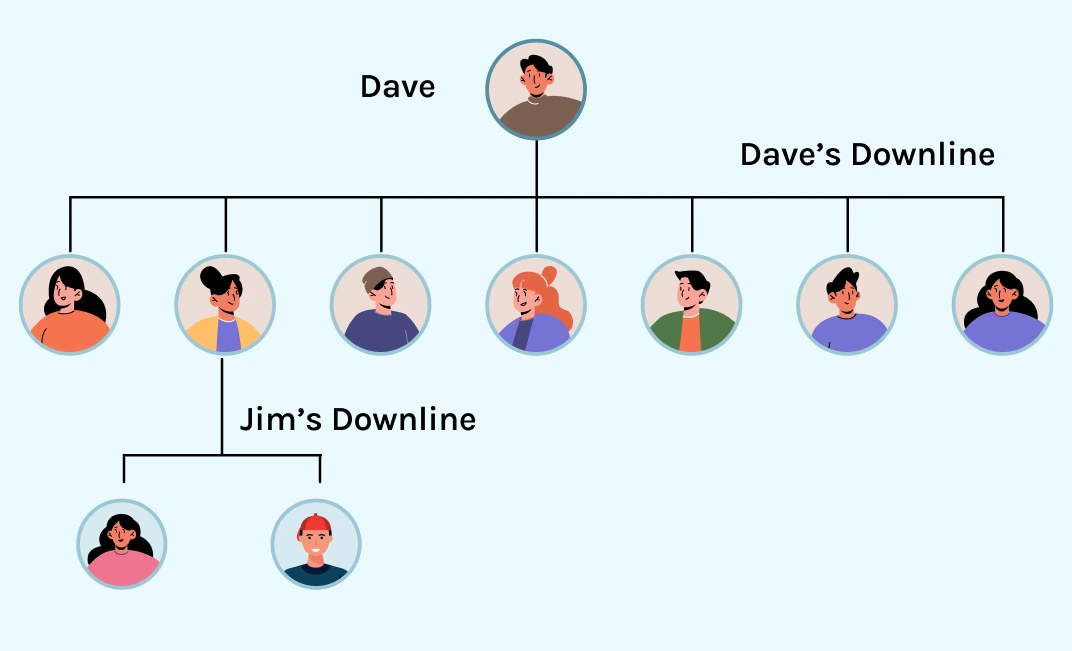
Dave joins as a distributor with an MLM business. All the members he recruits are placed directly under him, side by side.
Now, Jim is one of Dave’s recruits. He starts recruiting his own team members, who are placed under him.
So, Jim’s downline becomes Dave’s 2nd level.
The structure continues to build vertically, level by level, as each distributor builds a team, and horizontally, as they add more members to the team.
Commission structure in the Unilevel MLM plan
When it comes to commissions, the unilevel plan typically offers fixed commission percentages across multiple levels.
Also, there is a cap on the number of levels eligible for payouts. This helps keep the structure financially sustainable.
For example:
If Dave earns a 4% commission from the sales made by his downline, He may earn 3% sales from the next level, i.e., Jim’s downline, and so on.
Also, if the company allows distributors to be paid up to five levels, it means Dave earns commissions from sales made across five levels, as long as he meets the required qualifications at each level.
All these qualifications and complicated commission calculations can easily be handled by the unilevel MLM software.
Who Should Use This MLM Compensation Plan?
Unilevel MLM plans are perfect for MLMs that rely on product movement and customer retention, like health and wellness MLMs, essential oils, personal care, and skincare MLMs. The plan supports both active selling and team building.
Real-Life Use Case
DoTERRA is a perfect example of an MLM that follows a classic unilevel plan. Here’s how it works:
Distributors start earning commissions after a 60-day "Fast Start" period.
If someone within those seven levels doesn’t qualify for a payout, the commission moves up to the next eligible upline.
One of the unique features of the doTERRA compensation plan is that it pays higher percentage commissions on the deeper levels (e.g., up to 7% at level seven), contrary to the traditional model that pays higher at upper levels. This way, the focus is on depth rather than short-term width.
doTERRA rewards rapid team growth with a 20% Fast Start bonus for the first 60 days and a Power of 3 bonus starting at $50, as distributors build more teams.
2) Binary MLM plan
The binary MLM plan is another popular network marketing compensation plan. Under this, each distributor is allowed to sponsor only two members in their downline, one on the left and one on the right, creating a binary tree.
This kind of structure grows downwards as more members are added, but has a restricted horizontal growth.
Any additional recruits apart from the first two members are placed further down in the structure, in the next available position. The process is called spillover. Also, distributors are encouraged to balance both legs in terms of sales volume to maximize payouts.
Distributors also offer training, mentoring, and support to the team members, as their commissions are tied to the team’s performance. This creates a strong team culture where the distributors benefit from their downlines’ performance, and in turn, the downlines receive the necessary training and support.
Let’s try to understand this MLM compensation plan with an example.
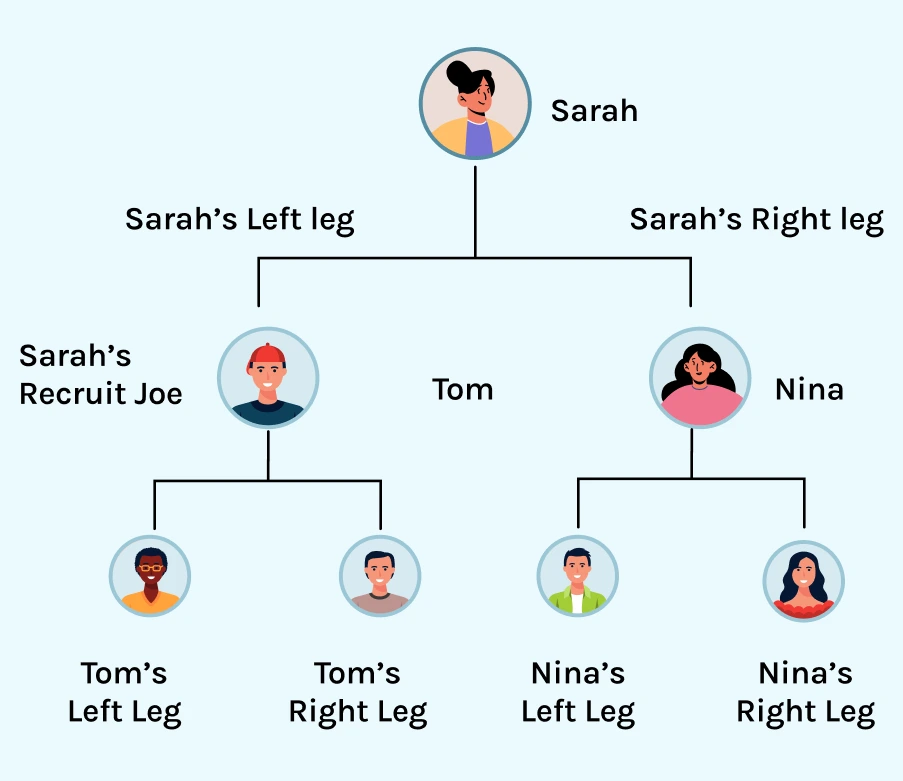
Sarah joins an MLM company that follows a binary MLM plan.
She recruits Tom on her left leg and Nina on her right leg.
Now, Sarah has already filled two positions in her downline.
If Sarah recruits another person, Joe, he will be placed under either Tom or Nina. In this case, let’s just say that Joe is placed in Tom’s left leg. Now, Tom has to recruit only one member on his right leg to complete his binary tree.
This creates a deeper structure that grows downward. Also, team balance becomes a key strategy here.
Commission Structure in the Binary MLM Plan
The binary MLM plan is a performance-based structure where commissions are calculated based on the sales volume of the weaker leg. This way, distributors are encouraged to maintain a balance between both legs rather than focusing on the growth of only one.
For example:
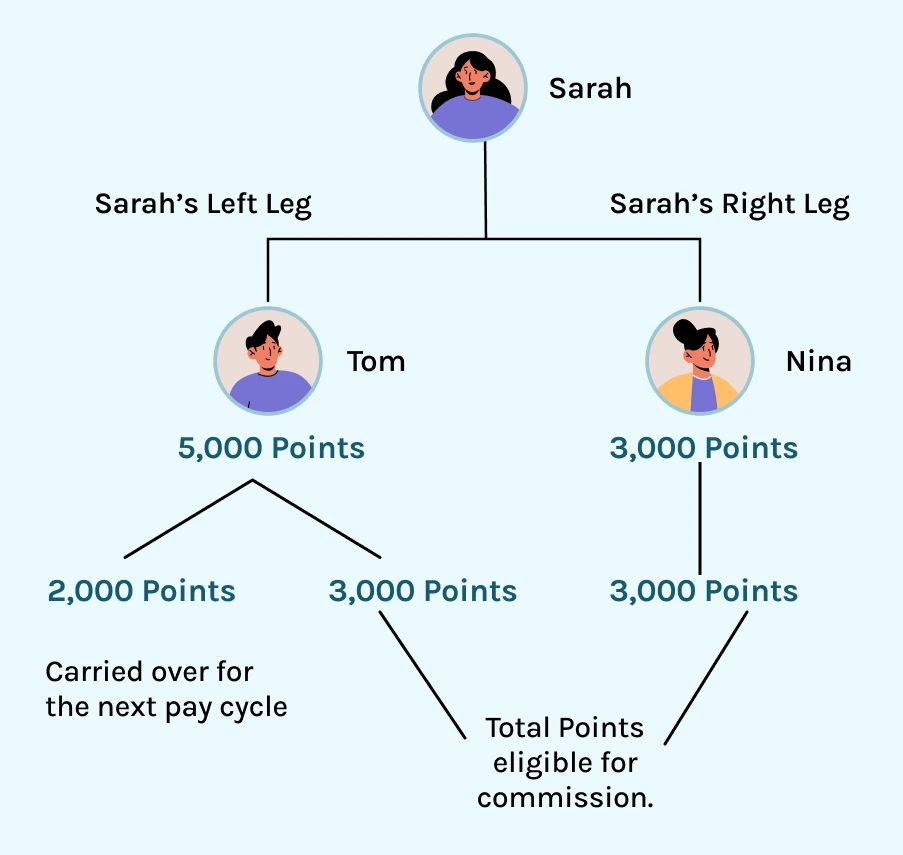
Let’s imagine that Sarah’s left leg generates 5,000 points in sales and her right leg generates 3,000 points; she will receive commissions based on the 3,000 points, since it is the leg with the least volume.
So, the company matches this volume from both legs and pays commissions based on this.
But since the left leg generated 2,000 more volume, this volume is carried forward to the next pay cycle.
This means that Sarah’s left leg begins the next pay cycle with 2,000 points. This way, the distributor’s efforts are not wasted.
Also, most MLM companies set a cap on weekly or monthly earnings to help keep the compensation plan financially viable. Binary MLM software is the best way to keep track of binary teams and calculate commissions without much human intervention.
Who should use this MLM compensation plan?
The Binary structure is best for companies that want to build deep, motivated teams in a shorter amount of time, like in fitness MLMs, crypto, nutrition, or digital services.
This MLM compensation plan encourages teamwork, motivates downlines through spillover, and rewards distributors who work hard to maintain a balance between both legs.
Real-Life Use Case
Atomy is one of the most successful binary MLM companies that has employed this structure. Under the plan:
Distributors are required to build and maintain two teams and balance sales volumes between them.
Atomy calculates commission based on the sales volume of both teams. The greater the balance, the higher the payout.
Distributors can earn a general commission of up to 44% once both their left and right teams reach specified sales volumes.
Atomy also offers additional incentives, called “Mastership Bonuses,” for distributors who help their team grow and achieve higher ranks.
3) Matrix MLM plan
The Matrix MLM plan is designed for controlled and predictable growth. Under this plan, each distributor builds a team with a fixed width and depth that the MLM company sets.
For example, a 3X5 means each distributor can only have three recruits under them, and the network will extend to only five levels. Any extra recruit will be placed in the next available slot within the matrix. This forced placement system is also the reason why it is called a “Forced Matrix plan.”
Let’s take an example for easy understanding.
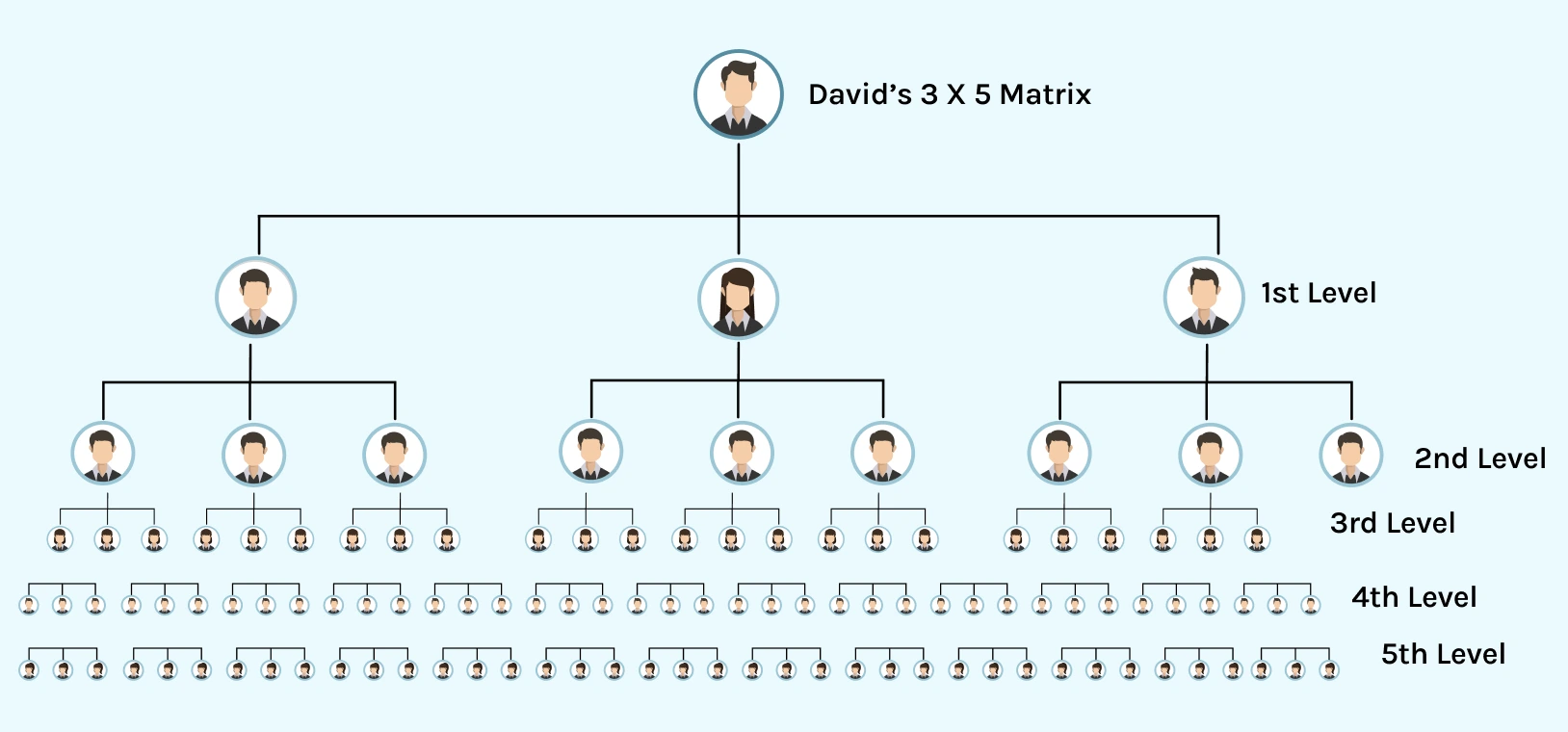
David joins as a distributor in an MLM company, which employs the 3X5 matrix.
He recruits three distributors, thereby filling the first level.
Each of these members recruits other members under them, forming the 2nd level.
This pattern continues until David’s network expands up to 5 levels.
Commission Structure in the Matrix MLM Compensation Plan
Commissions within the matrix plan are usually paid when distributors fill specific levels of their matrices. Most MLM companies also provide matching bonuses when their personally sponsored members complete a level or a matrix of their own.
Let’s take David’s Example forward:
As per the company’s 3X5 matrix plan, David recruits 3 people, which fills his 1st level.
Each of these 3 members recruits 3 people. So there are a total of 9 members in the 2nd level.
This pattern continues until David’s matrix is completely filled with 363 members over 5 levels (3 + 9 + 27 + 81 + 243 = 363).
As David’s matrix fills, he earns commissions based on each filled level. For example, he may earn:
$5 per member on Level 1
$3 per member on Level 2
$2 per member on Levels 3 to 5Once a level is fully occupied, David unlocks the commission for that entire level.
If one of David’s personally sponsored members also fills their matrix, David receives a matching bonus as well.
And because there is a fixed width and depth, payouts are easier to predict and control. Also, the payouts across these matrices can be automated using Matrix MLM software.
Who should use this MLM compensation plan?
The Matrix structure is a strong choice for companies that want a network marketing compensation plan designed for sustainable and well-managed expansion. It is perfect for niches like digital tools, online education, subscription boxes, and niche wellness products.
Real-Life Use Case
LiveGood MLM company is a prime example of a brand using the Matrix MLM plan:
Its compensation plan requires distributors to fill a 2X15 matrix, known as a business center. You can also count it as a mix of binary and matrix plan, as the width is capped at two recruits.
Level commissions start at 2.50%, and 50% of Matrix commissions are paid as a matching bonus.
Additional income streams include a customer acquisition bonus of 10% on a customer’s first product order.
Members share 2% of total company sales when they reach the diamond rank and 0.5% when they reach Crown Diamond
4) Stair Step MLM Plan
As the name suggests, the Stair Step MLM plan is a marketing network visualized in the form of a “staircase.” Distributors move up a staircase for ranks and titles based on their sales and the sales of their teams.
Under this MLM compensation plan, MLM companies set a specific sales target for each rank. When distributors achieve the targets, they move to the next rank. There are no width and depth limits, so a distributor can have any number of members in their downline.
Also, the top distributors who reach the highest rank can break away from their upline and create their own teams. This feature is the reason why the plan is also called the “Breakaway” plan.
While the levels are in the form of stairs, team building is usually done by integrating it with other MLM plans like Binary, Matrix, and Unilevel.
Let’s understand this with the following example.

Distributor Kathy joins a network marketing company, which follows the Stair Step/ Breakaway MLM Plan, integrated with the unilevel MLM plan.
She starts at the Associate level under her upline sponsor, Ben.
She requires 1,000 Personal Volume to reach the next level of Manager.
Similarly, there are different criteria for each level, with the highest level being the seventh level of Senior Director.
Within the course of her career, she climbs all levels by attaining the target for each and receives the title of Senior Director.
Here, she breaks off from her upline, Ben’s team, and establishes her own team by carrying her downline with her.
Commission Structure in the Stair Step MLM Compensation Plan
Some commissions commonly paid under this rank include direct commissions, rank bonuses, and override commissions. Also, distributors unlock higher earning percentages as they move up the “stairs.”
However, when a distributor breaks away from their upline, it reduces direct earnings for them. Therefore, some MLM businesses may allow the uplines to earn a certain percentage of the new team’s volume as overrides.
In this case,
As Kathy climbs the ranks from Associate to Manager, then Supervisor, and so on, she receives increasing commission percentages.
For example:
As an Associate, she earns 5% direct commission on her personal sales.
Upon reaching Manager, she starts earning 8% on her personal sales and 3% override commissions on the sales of her downline.
As Director, Kathy qualifies for rank advancement bonuses, such as a $500 one-time bonus or additional incentives like travel rewards or product bundles.Now that Kathy has reached the Senior Director level, she qualifies to break away from her upline, Ben. She forms her own team and takes her existing downline with her. This move gives her full control over her group and higher commission percentages.
But when this happens, Ben’s monthly volume may suffer a bit. However, if the company allows for overrides, he may still earn a small percentage of commissions on the sales volume achieved by Kathy and her team.
As the teams grow and breakaways increase, tracking ranks, overrides, and bonuses are handled through the Stairstep MLM software.
Who should use this plan?
The Stairstep structure is best for MLM businesses that want to build a legacy of stronger teams with exceptional leaders. It is a powerful model among the MLM compensation plans, especially for wellness, nutrition, and makeup MLM companies, where the distributors are led by a strong leader who builds a trusted personal brand and a set of loyal customers.
Real-Life Use Case
Herbalife MLM company is a prime example of a Stairstep/breakaway MLM plan in action, particularly in the health and nutrition space. Here's how this model works:
Its compensation plan starts with the Distributor at the first level and the President’s Team at the seventh level.
Once they achieve the Supervisor status, they qualify for up to 5% royalty overrides on three levels of downline volume, plus production bonuses between 2%–7% as they progress to Millionaire and President ranks.
Distributors must maintain their qualifications annually to keep their titles.
This kind of model creates a clear growth path for ambitious distributors while helping the company scale and attract top talent.
5) Board MLM Plan
The Board MLM plan is a compensation structure that operates on a cycle-based system. In this plan, distributors need to recruit members to fill a fixed-sized board.
MLM companies specify these boards in a 2X2, 3X5, 4X4 format, where the first number denotes the number of members each distributor can recruit, and the second number denotes the number of levels the board will have.
So, if the board is 2X2, it means that each distributor will recruit two members, and the board will have two levels.
Once the board is completed, the distributor at the top will move out of the team and start with a new board or advance to a higher-level board, depending on the company’s rules.
This plan is also called the recycling matrix plan since the distributor’s position is recycled to a new board.
Let’s break it down with an example.
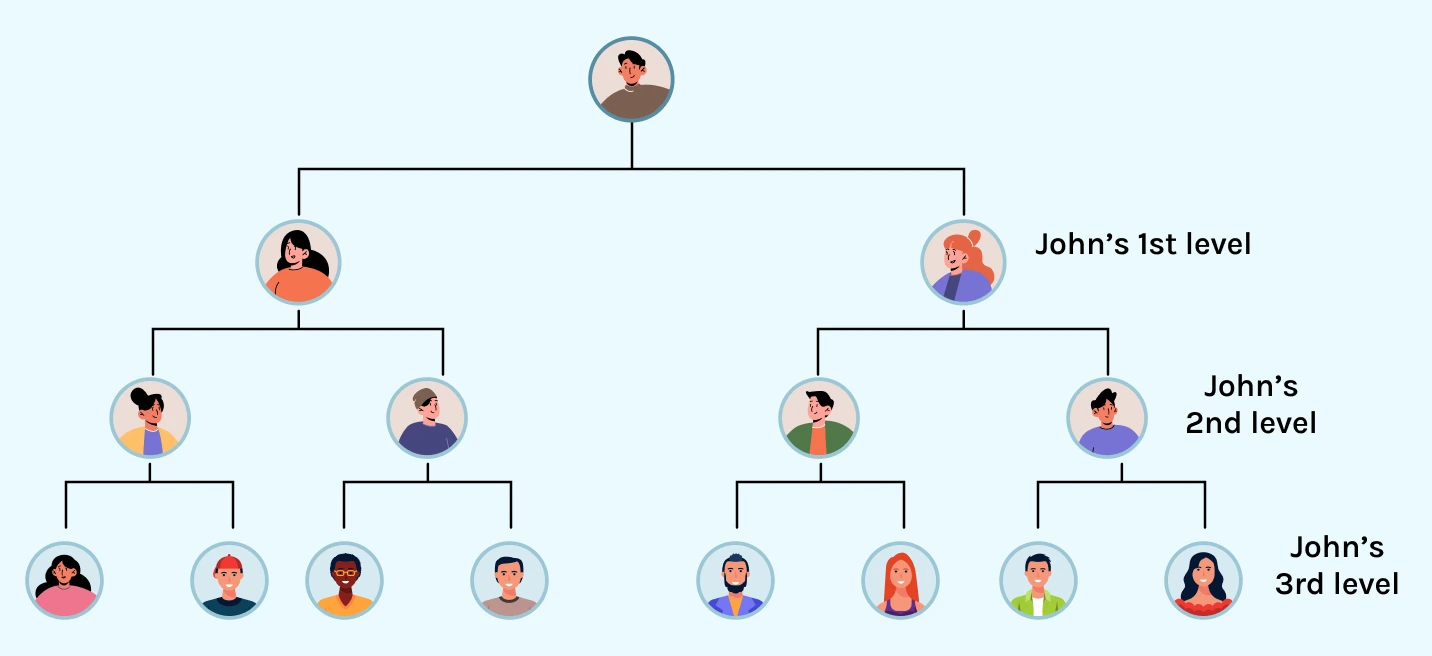
John is a distributor with an MLM company that employs the Board MLM plan, with a 2X3 structure.
So he recruits two members in his downline, which will become level 1.
Then, these downline members will recruit two members each, which will form level 2.
Similarly, the members in level 2 will recruit two members each, forming the 3rd and the last level of the board.
Now that the board is complete, John will move out of the board and will start a new board or level up into a higher board, whichever is applicable.
Commission Structure in the Board MLM Compensation Plan
Commissions in this plan are paid when a distributor completes their board. But the amount varies. While companies pay a fixed amount upon completion of a board, other companies reward with promotions, rank upgrades, or provide entry into premium boards with higher earning opportunities.
In the case of the above example,
John will receive a board completion bonus when he completes the 2X3 board. Let’s say the company offers a $500 bonus for completing this initial board.
If he is moved to a premier board, he will receive higher commission percentages and/or rank advancement benefits. In this new board, the payout structure might look different:
— Completion bonuses could increase to $1,000 or more.
— He might also earn cycle bonuses every time a downline member completes their own board.
— Some companies also offer rank advancement or special perks, such as early access to training, recognition, or event invitations.
Since boards are constantly shifting and cycling, Board MLM software helps automate board splits, manages transitions smoothly, and ensures the bonuses are distributed accurately.
Key Differences Between Matrix MLM plan and Board MLM plan?
| Feature | Board MLM Plan | Matrix MLM Plan |
|---|---|---|
| Structure Type | Rotating group-based structure (boards split and reformed) | Fixed-width and fixed-depth grid-like structure |
| Position Limit | Limited positions per board (e.g., 2x3, 3x2) | Fixed width × depth (e.g., 3x5, 4x7) |
| Movement | Dynamic; members cycle in and out of new boards | Static; members fill pre-defined positions |
| Commission Trigger | Completion of a board | Filling a level in the matrix |
| Recruitment Flow | The top member moves to a new board after completion | Members are placed sequentially in the next open slot |
| Spillover Effect | High. Spillover is common during board splits | Moderate. Depends on upline's activity |
| Leadership Building | Encourages leadership via cycles and progression | Encourages controlled growth and depth management |
| Best For | Fast-paced, high-momentum teams and digital products | Controlled, scalable teams in niches like education or wellness |
| Payout Consistency | Variable, based on board cycles | More predictable due to set levels and structure |
Who should use the Board MLM compensation plan?
The Board MLM plan is best suited for MLM companies that want to promote a structured way of team building. They also have complete control over the number of recruits and payouts.
The plan also encourages distributors to build teams in a phased and organized manner while controlling the growth and performance of the team.
This kind of structure can benefit MLM businesses like digital services, training platforms, and niche wellness products, where teamwork, leadership, and controlled progress are essential for long-term success.
6) Generation MLM Plan
The Generation MLM Plan is probably one of the most widely used network marketing compensation plans. It is also known as a “gap commission” or “repurchase plan.” The Generation MLM plan encourages distributors to build extensive networks in both depth and width.
Under this plan, each distributor builds a generation, which includes both its recruits as well as its customers. While the recruits are placed vertically, each recruit builds their own team. Levels in this plan are usually referred to as generations.
The following example will make the concept clearer.
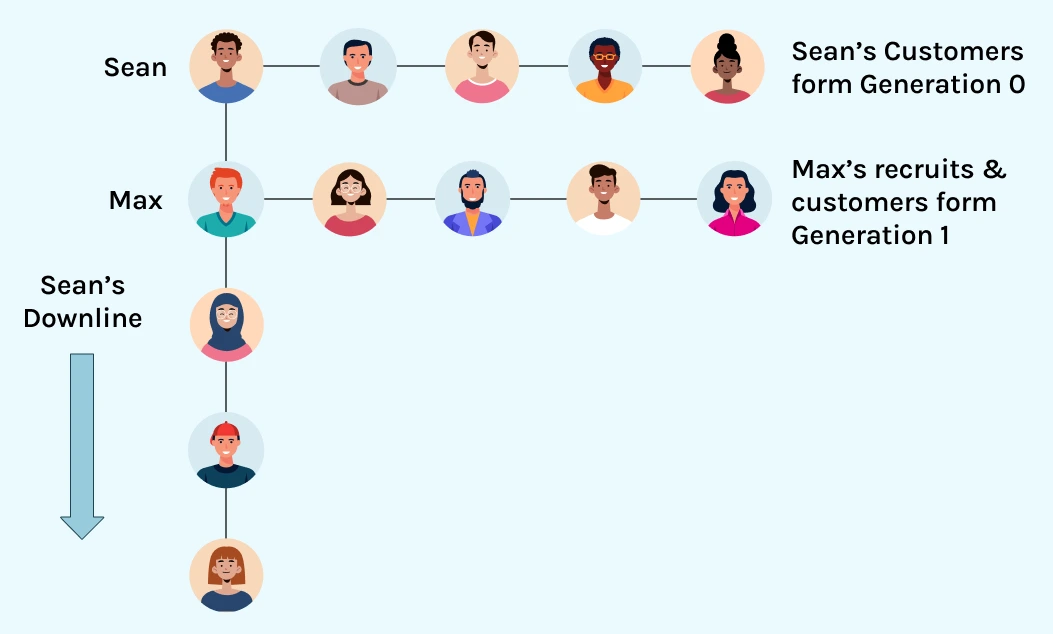
Sean joins an MLM company that uses the generation MLM plan.
He forms Generation 0, and all his customers are placed next to him horizontally, while his direct recruits are placed below him, vertically.
Now, Sean recruits a new member into his team, Max, who is placed under Sean.
So now, Max’s recruits and customers are placed next to him horizontally, and they form Generation 1.
This pattern continues to form a wide network.
Commission Structures in the Generation Plan:
The generation MLM plan typically pays distributors for their first few generations, commonly 2 to 5 generations deep, depending on company policy. This is called generation overrides, and it decreases with each generation.
Let’s continue with Sean’s example:
As Sean begins building his network, his direct recruit, Max, and Max's recruits form his Generation 1.
Suppose Sean earns a 7% override on the total sales generated by this generation.
Now, when Max recruits Anna and she starts building her own team, they form Generation 2 in Sean’s network.
Sean might now earn a 5% override on Generation 2’s sales, and so on, reducing slightly with each deeper generation.
Let’s say Sean’s MLM company allows payouts up to five generations deep. That means Sean could earn progressively lower commission percentages down to Generation 5—for example, 7%, 5%, 3%, 2%, and 1%.
Additionally, Sean gets referral bonuses for every new member he personally brings in, such as a one-time 10% bonus on their first purchase or registration package.
Distributors can also earn a percentage of team sales from a fixed number of generations and referral commissions, which are calculated using a specialized system like the Generation MLM software.
Who should use this plan?
This is one of the best MLM compensation plans in network marketing for businesses following the e-commerce model, and selling consumables or subscription products, where the revenue is driven by repeat purchases.
Real-Life Use Case
Oriflame uses the generation MLM structure to reward its distributors.
Any Consultant who achieves director level or higher becomes eligible for generation bonuses.
There is a 1% commission on directly sponsored teams.
This increases to 3% on generation 1
As distributors progress to Sapphire rank or higher, the generation bonuses can extend up to 5 generations deep, with each level roughly offering 3% commissions.
7) Monoline MLM plan
The monoline MLM plan, also known as the single-leg MLM plan or the linear MLM plan, is the easiest structure to understand. Under this plan, all distributors are placed in a single line, one after the other, regardless of who sponsors them.
There are no horizontal or vertical branches. Everyone in the organization is part of a single unified downline. Members are usually placed on a first-come, first-served basis.
Let’s understand this with an example:

Sophia joins an MLM company that practices the Monoline compensation plan. She is the first distributor to join the network and is hence placed right on top.
When John joins the network, he is placed under Sophia.
Next, Sophia sponsors Daisy to join the network, who is placed under John.
This way, a single line of network is formed.
This structure is rated among the best MLM compensation plans, especially for newcomers, since it is easy to understand, and they receive the full support of their upline to progress.
Commission Structure in the Monoline MLM Compensation Plan:
In a monoline MLM plan, commissions are distributed based on a distributor’s position in the line and the total volume generated by the team under them.
Continuing with Sophia’s example:
As the network grows, Sophia earns commissions not just from her own sales but also from the sales made by John, Daisy, and every distributor added below her, regardless of who sponsors them.
Let’s say the company offers a 5% commission on sales from the next 10 members below a distributor. Sophia would receive a 5% cut from the sales generated by John, Daisy, and the next 8 members who follow in the line.
Payouts are limited to a certain number of levels, which are often tracked using the Single Leg MLM software.
Who should use this plan?
This type of compensation plan is ideal for companies dealing with low-cost products, digital subscriptions, or services with wide appeal. It can work really well when the products are combined with strong marketing campaigns and limited edition deals.
8) Party MLM plan
The Party MLM plan is the most traditional and relationship-driven network marketing model. It is commonly referred to as a “home party plan” or “social selling model.”
Under this plan, distributors are referred to as consultants or hosts and are encouraged to host parties, either in person or online, and demonstrate products.
This model differs from the others because it neither focuses on team building nor recruitment. Instead, it emphasizes creating a fun and personal experience for the prospective buyers. However, some customers eventually decide to join the marketing network, leading to organic growth.
While the Party MLM plan focuses primarily on delivering a warm, personal customer experience, many companies combine this approach with other network marketing compensation plans, like the Unilevel or Binary plans, for team building and expansion.
Let’s understand this with the below example:
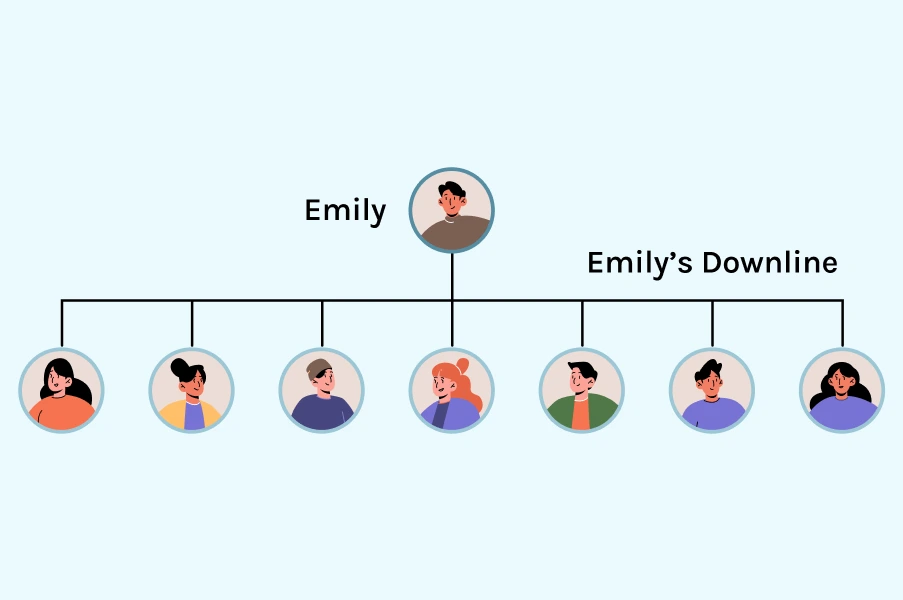
Emily joins a party plan MLM company that sells kitchenware. It also integrates the unilevel MLM structure to reward sales and team-building efforts.
She invites her friends and neighbors to a weekend cooking demo at her home.
She demonstrates the products during the event, takes orders, and earns commissions based on total sales.
Two of the guests show interest in the company’s business plan and eventually sign up to become consultants. They become Emily’s downline in the unilevel structure.
Emily also earns a percentage of commissions on their sales and receives additional bonuses based on the depth of her team. This combination lets Emily enjoy commission on her sales, as well as the sales of her team, creating a stable and sustainable income stream.
Commission structure in the Party MLM Compensation Plan:
Commissions in the party plan model are based on the sales generated during a party event. Some companies try to make it more rewarding by offering free products to hosts, or even party bonuses if the sales of a party exceed the limit set by the company.
The consultants are also earning through team-building bonuses, based on the company’s commission structure, giving them an added layer of earnings from the sales made by their teams.
Let’s continue with Emily’s example:
During her weekend cooking demo, Emily generates $1,200 in product sales. Based on the company’s compensation structure, she earns a 20% commission, giving her an immediate income of $240 from that event alone.
Because her party sales crossed a $1,000 threshold, she also qualifies for a party bonus, which is a free kitchenware set worth $80, which she can use for future demos or personal use.
Later, as her guests-turned-consultants begin hosting their own parties and generating sales, Emily earns 10% on their direct sales as part of the unilevel team-building structure.
As her team grows deeper, she becomes eligible for tiered bonuses, such as 5% on second-level team sales, if she meets monthly personal sales requirements.
Consultants are also provided with tools like Party Plan MLM software to track bookings, sales, guest lists, and commissions effectively.
Who should use this plan?
The Party MLM plan is perfect for companies that can benefit from product demonstrations, like home decor MLMs, or MLMs dealing with kitchenware, cosmetics, personal care, or fashion accessories. It’s a great fit for brands that place high value on community engagement, customer experience, and create a fun, low-pressure selling atmosphere.
Real-Life Use Case
PartyLite is a well-known company that uses the party MLM Plan model. Here is how it works:
Sellers start as Consultants and progress by developing teams. Higher levels include Senior Regional Vice President, which includes deeper levels of profit sharing.
Once a seller advances to Team Builder, they earn both personal sales profits and a profit share from their team’s performance. Here is a 25% profit on personal volume and and 7% bonus when they reach certain levels.
As they move up to titles like Regional Leader or Senior VP, they also become eligible for monthly override bonuses, team volume rewards, and elite recognition awards like trips and jewelry.
Conclusion
Choosing the best MLM compensation plans is one of the most important factors you must consider for your MLM business. However, there is no one-size-fits-all plan.
You need to evaluate things like your product range, recruitment requirements, leadership growth, and scalability, and choose a plan that fits the criteria and supports your long-term business goals.
When it is done in the right way, the right compensation plan not only serves as a system to pay your distributors but also becomes your growth engine.
FAQs
1. What is a compensation plan in MLM?
An MLM compensation plan is an important aspect of any MLM business. It explains how distributors will earn from selling products and building a team.
2. Which are the MLM companies with the best compensation plans?
Some MLM companies with the best compensation plans include Amway, Herbalife, doTERRA, Livegood, and Mary Kay. These companies have carefully designed their compensation structure to reward both sales and team building, along with remaining sustainable in the competitive market.
3. How do network marketing compensation plans affect distributor success?
Compensation plans play a huge role when it comes to distributor success. When a plan is well structured, it promotes fair earnings, team support, and growth incentives.
4. Why do MLM plans matter in network marketing success?
MLM plans are the backbone of your business. They decide how your marketing network will grow, and how your distributors will earn. A good network marketing compensation plan will also help you retain distributors, which will, in turn, affect how your customers perceive your brand.
5. Can a company switch MLM plans later if needed?
Yes, it can be done. But a few things should be kept in mind. Switching MLM plans can disrupt your network and create trust issues. If you are considering a change due to market shifts, you can choose a flexible compensation plan that allows you to make changes without disrupting the entire flow of your business.
References
-
arxiv.org
Disclaimer: Global MLM Software does not endorse any companies or products mentioned in this article. The content is derived from publicly available resources and does not favor any specific organizations, individuals or products.









